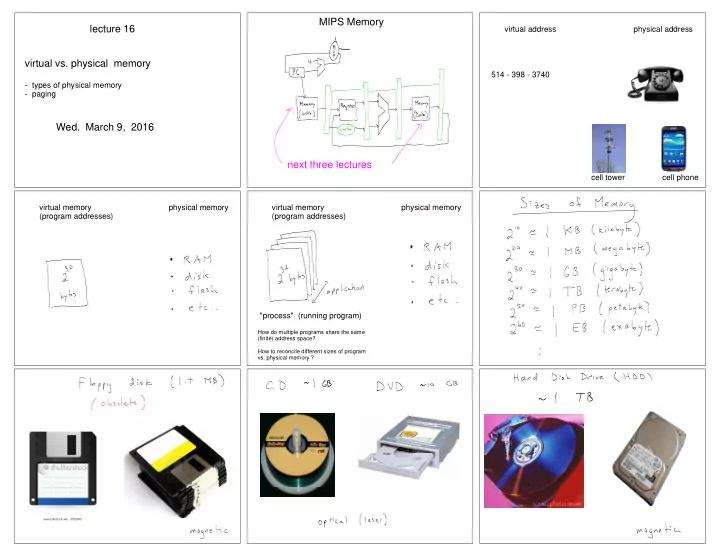

MIPS Memory lecture 16 virtual address physical address virtual vs. physical memory 514 - 398 - 3740 - types of physical memory - paging Wed. March 9, 2016 next three lectures cell tower cell phone virtual memory physical memory virtual memory physical memory (program addresses) (program addresses) "process" (running program) How do multiple programs share the same (finite) address space? How to reconcile different sizes of program vs. physical memory ?
Memory Hierarchy We would like to access Memory in one clock cycle. However, there is a tradeoff between the speed and size of physical memory (can't be large and fast). fast and expensive (thus, small) slow and cheap (thus, large) lecture 16 Paging virtual memory physical memory virtual vs. physical memory - types of physical memory MIPS - paging Memory - how to translate (map) virtual to physical ? - page tables size ~MB ~GB ~TB - page fault and page swap There is nothing significant about the square tile number of 1 ~10 10^6 geometry in this clock cycles / sketch. access
Example: suppose 1 page = 2^12 bytes Q: How to translate a virtual address to a physical How to translate (map) a virtual address to a physical address? address ? How many pages? A virtual address is 32 bits. These are the program 40 / 2^12 = 2^28 pages addresses we have been talking about for the last few Virtual Memory Physical Memory weeks. RAM (4 GB = 2^32 bytes) (e.g. 1 GB = 2^30 bytes) --> 2^32 / 2^12 = 2^20 --> 2^30 / 2^12 = 2^18 pages Again, take example that a page is 2^12 bytes. pages 31 ... 12 11 ... 0 HDD page offset (e.g. 1 TB = 2^40 bytes) virtual page number Note that both the user part of Memory and (part of the) --> 2^40 /2^12 = 2^28 pages kernel part of Memory is paged. virtual address virtual address "Page table" 31 ... 12 11 ... 0 31 ... 12 11 ... Data structure in kernel that translates (maps) a virtual page number (address) to a physical page number (address) page offset page offset virtual page number virtual page number virtual page valid physical page number number (VPN) bit table lookup table lookup copy copy page offset page offset physical page number physical page number 29 ... 12 11 ... 0 39 ... 12 11 ... 0 physical address (RAM) physical address (HDD) e.g. 1 TB = 2^40 bytes e.g. 1 GB = 2^30 bytes "Valid bit" says whether page is in RAM (1) or on HDD (0). Where are the page tables ? Page Fault and Page Swap Next week's lectures - When a MIPS program tries to access an address whose physical - more on page tables (we need a cache for them too !) page is on disk (HDD), we say that a "page fault" occurs. The page first must be brought into main memory (RAM) before the program can - how do caches work ? access that address. - If there is no page available in main memory, then some page first must be moved out of main memory, and then the desired page can be moved in main memory. This is called a page swap. - The page table must be updated (regardless of whether a page is swapped out). Page swaps are done by a kernel program (OS) called the page fault Page tables are in a reserved data region in the kernel part handler (return to this in lecture 21 -- interrupts). of MIPS Memory . Note that they have both a virtual and a physical address. The page table region is not partitioned into pages. Rather this region has a fixed mapping from virtual to physical memory. replace these virtual memory boxes by caches
Recommend
More recommend